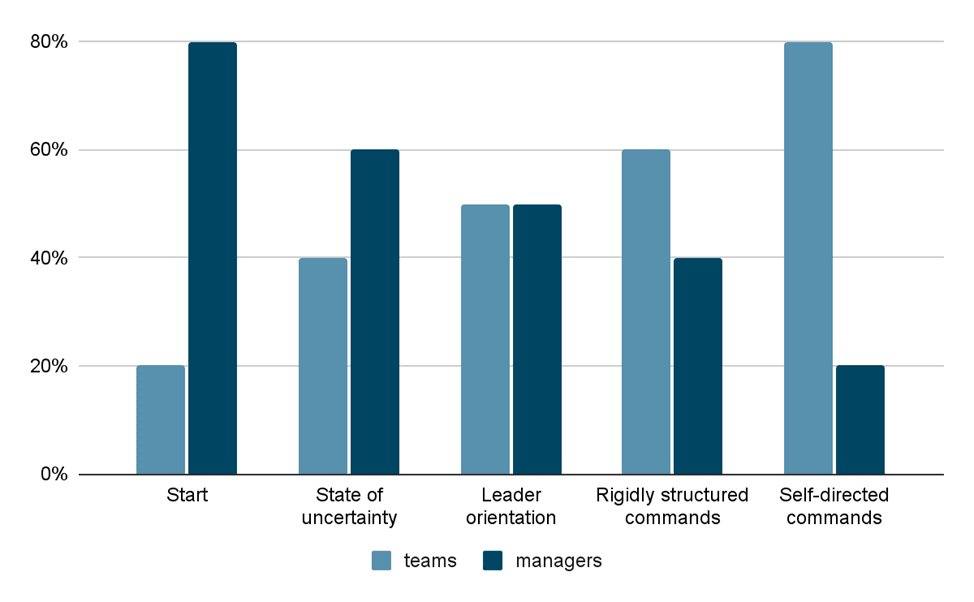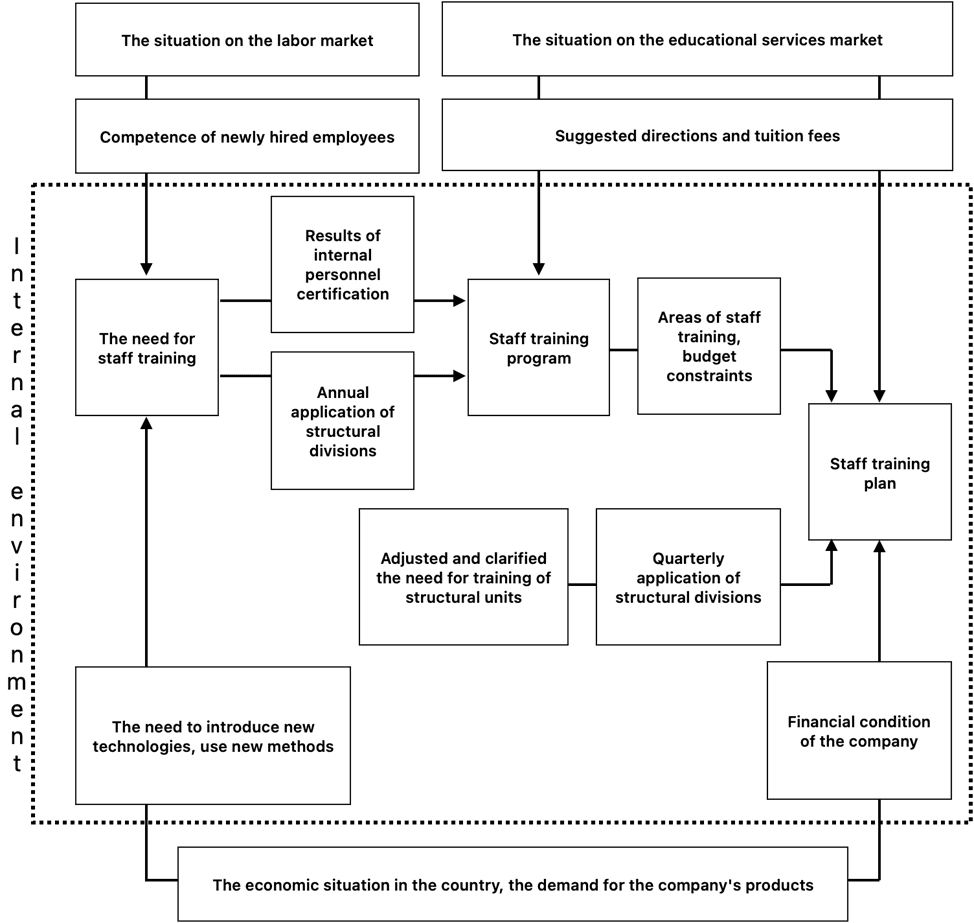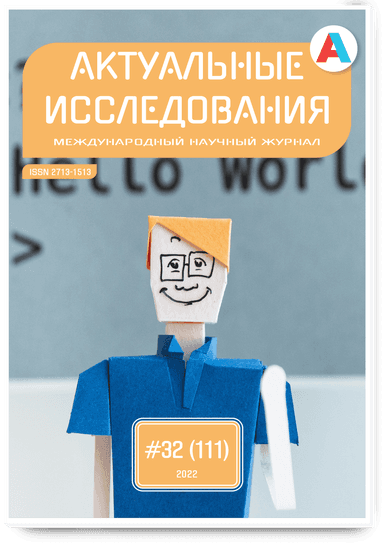Introduction
In the conditions of the current working capital shortage in many enterprises, employees have become more crucial assets than ever before. During economic crises, the "qualitative" characteristics of personnel gain particular importance because it is highly skilled professionals with creative thinking who can find non-standard solutions to overcome the problems caused by the global economic recession.
It should be emphasized that the key factor directly impacting the quality of personnel is the personnel development system. This system plays a significant role in the overall human resource management strategy and contributes to strengthening the company's competitive position in the market. The goal of personnel development is to create and maintain a pool of talent, enhance employees' professional expertise, develop their contemporary economic thinking, and improve their teamwork abilities, ultimately leading to high labor productivity and effective enterprise functioning as a whole.
Today's corporate leaders are paying increasing attention to attracting personnel, as this stage is where an organization forms a team that meets the needs for qualified employees. Additionally, this phase creates the initial impression of the organization and its employees. However, one of the most labor-intensive and responsible stages in personnel management is the search and evaluation of the skills and abilities of prospective employees. Effective candidate assessment provides an additional guarantee of alignment between the company's interests and the candidate's qualifications. HR specialists, using this tool:
- Collect the most comprehensive information about the candidate, which can be added to the database and saved for future use, even if the candidate is not suitable for the current vacancy.
- Communicate with the candidate in a professional manner, demonstrating the company's interest, which brings additional benefits in long-term relationships and can influence the candidate's choice in favor of the company when considering multiple job offers.
- Help screen out candidates who do not possess the competencies required for a specific position.
- Engage the candidate in finding solutions based on real company cases, which can be utilized in their work after successful hiring [1].
I. Selection of Personnel Assessment Methods
Currently, various assessment methods are employed in the practices of companies, and the main ones will be discussed below:
- Assessment Center: A comprehensive procedure designed to evaluate employees' competencies within a specific task. It includes elements of behavioral interviews and cases specially developed for the required competencies. The distinctive feature of the assessment center is the multiple evaluation of candidates for each criterion in different contexts.
- Competency-Based Interviews: This method allows for the identification of behavioral aspects of an employee's personality that manifest during problem-solving and achieving results at work.
- Case Interviews: A technique involving the presentation of specific situations in which the candidate must describe their decisions or behavior.
- Meta-program Interview: A method based on questions aimed at revealing a candidate's thinking characteristics, decision-making, motivation, and preferences in the work environment.
- 360-Degree Feedback: An assessment of the employee conducted by polling their business environment, including managers, colleagues, and subordinates.
- Testing: A standard approach for measuring an individual's properties and qualities important for performing job tasks.
Each of these methods has its unique characteristics and is applied depending on the assessment goals and specific situations [2].
II. Interviewing
The hiring process is a sequence of activities conducted by an organization with the aim of attracting candidates possessing the necessary qualities for the successful achievement of the organization's goals. The primary task of the candidate assessment and selection system is to find the best fit between the organization's objectives and the candidates for vacant positions. Before commencing interviews and the employee recruitment process, it is essential to conduct a team needs analysis and answer questions such as: What specific expectations exist for new team members? What skills, experience, and personal qualities are required for successful performance?
Creating a clear candidate profile will help you precisely identify who you are looking for. Next, prepare thoroughly for the interview. AI can help in this matter, since it is currently widely used to perform various tasks. In the field of text analysis, AI is still showing limited abilities. The questions he suggests seem too simple. It provides an extensive list of keywords that can be used during the interview. For example, when passing an interview, Google AI gives basic help. Perhaps his main goal is to help those who are very nervous at interviews. Since people can train by talking to a robot, and then calmly revise their answers so that the system will rate them more highly. This is probably more effective than practicing in front of a mirror.
When asking questions that will help assess the candidate's skills and experience, as well as his/her compliance with your company's culture, pay attention to communication skills and personal qualities, such as responsibility, initiative and ability to cooperate. Don't forget to check the candidate's references. Communication with previous employers or colleagues can provide valuable information about how a candidate copes with responsibilities and interacts in a team.
Based on the above, you can outline the approximate stages of an interview:
- Introduction, establishing rapport.
- Gathering basic information from the candidate.
- Informing the candidate about the offered position and the company.
- Answering the candidate's questions.
- Concluding the interview [3].
III. Team Formation Process
Various approaches and methodologies to the team formation process are discussed by both management theorists and practitioners. Different strategies implemented in the team formation process significantly impact organizational procedures related to the implementation of new practices. In the context of organizations in the United States, a specific algorithm exists for organizing collective labor processes:
- Identification of a high-performance work group. This stage includes the nominal group technique (NGT) to generate ideas aimed at improving efficiency. Then, ideas are ranked, and consensus is reached.
- Continued group discussion. The group continues to discuss the results of NGT, forms smaller teams, and identifies priority ideas based on NGT.
- Problem-solving by teams. Teams develop project solutions, analyze issues, proposals, and projects.
- Reporting by teams to the group. The team presents its proposals to the group, which helps members gain skills in formulating and presenting ideas.
- Management meeting. Leadership evaluates the team's proposals and discusses implementation issues.
- Feedback from management. Leadership communicates its decision regarding the team's proposals and discusses implementation matters.
- Execution of the proposal implementation plan.
- Development of measurement processes, evaluation of proposal success, and feedback on results.
- Management develops a reward system, which can enhance employees' pride and motivation.
This algorithm represents a comprehensive approach to team formation, allowing for effective management and assessment of the team formation process and its productivity. It's worth noting that according to M. Biru's approach, there are four key approaches to team formation, with the first three considered primary methods of creating teams.
- Goal-Oriented Approach: This approach aims to improve the team's ability to define and implement common goals. The process typically includes consultations. Goals can be strategic or task-specific, such as increasing productivity or sales. They can also address the internal environment or more general processes.
- Interpersonal Approach: This approach focuses on improving interpersonal relationships within the group. It assumes that enhancing interpersonal competence contributes to the group's more effective functioning as a team. The primary goal is to build trust within the group, encourage mutual support, and improve communication among team members.
- Role-Based Approach: This approach involves discussions and negotiations among team members about their roles. It is based on the idea that team roles can overlap and complement each other. Changing the way roles are performed and perceived by team members can significantly impact team behavior and effectiveness.
Each of these approaches serves as a valuable tool for team formation and development, with the choice of a specific approach depending on the goals and circumstances of the organization. D. Yankelovich proposes an interesting approach to team formation and development, which includes the following stages:
- Initial Stage, during which the team is formed, and basic tasks and goals are established. At this stage, team members may be uncertain about their roles and responsibilities.
- State of Uncertainty: At this stage, the team may experience uncertainty and doubt about how to proceed. Conflicts and misunderstandings between team members may occur.
- Leader Orientation: In this stage, the team turns to the leader or supervisor for direction and support. The leader plays a crucial role in setting goals and creating structure within the team.
- Highly Structured Team: At this stage, the team becomes more structured and organized. Roles and responsibilities of team members become clearer, and trust among team members grows.
- Self-Managing Work Team: In the final stage, the team achieves self-sufficiency and the ability to manage its work without constant leader support. Team members can work more autonomously and make joint decisions.
This approach represents a step-by-step process of team development that enables the team to effectively achieve its goals and improve collaboration within the group. It also underscores the importance of leadership in the initial stages of team formation and the gradual transition to more autonomous team work in later stages.

Fig. 1. The ratio of the distribution of powers between teams and managers at certain stages of the development of work teams
In conclusion, team formation is more than just an organizational initiative in which tasks and responsibilities are delegated. Organizing team work means creating an efficient and capable team, selecting the optimal leadership style for that team and situation, harnessing the team's creative potential, and skillfully managing emerging conflicts. To achieve this, it is necessary to develop an adequate team formation mechanism, taking into account the organization's specific features [4].
IV. Methods for Optimizing Recruitment
To ensure clarity and transparency at each stage of selection, an automated business process system can be implemented.
Event recruiting programs involve the use of various PR events to attract new employees to the company and are currently the most promising method of personnel search. Event recruiting is integrated into event marketing and is primarily focused on attracting young professionals. One of the key features of event recruiting is that the employer presents themselves to a wide audience of potential candidates. This method increases the level of potential candidates' loyalty and, furthermore, encourages active participation of company employees [5, 6].
V. Organizing the Knowledge Transfer Process
Creating a training plan: After successfully hiring new employees, it is necessary to develop a training plan. Determine what skills and knowledge they need to acquire to make an effective contribution to the team's work.
Mentorship and on-the-job training: One of the most effective methods of knowledge transfer is mentorship. Assign experienced employees as mentors to newcomers. This will help them quickly adapt and integrate into the team.
Feedback and correction: Providing regular feedback to new employees is essential. Maintain open communication and a willingness to help them address any challenges. Adjust training based on the needs and progress of employees.
Table 1
Types of personnel training
|
Classification Feature |
Types of Training According to the Classification Feature |
|---|---|
|
Depending on Participants in the Learning Process |
- Internal Method: Preparation and execution of tasks using company personnel. - External Approach: Organization and execution of tasks with external experts. - Self-learning: Development and implementation of tasks independently by the employee. |
|
Depending on Integration of Learning Process and Work at the Enterprise |
- With Work Suspension: Employee is temporarily relieved of current duties during training. - Without Work Suspension: Employee performs primary responsibilities concurrently during training. |
|
Depending on Purpose |
- Primary Training: Initial training for employees without previous professional experience or education in the field. - Retraining: Training for employees who already have certain education to acquire a new specialty or profession. - Skill Enhancement: Acquisition of additional knowledge, skills, and abilities to improve professional skills and maintain relevance within the current profession or specialty. - Adaptation Training: Training aimed at assisting employees in successfully adapting to the new professional and social environment within the organization after joining the company or transitioning to a new position. |
|
Depending on the Number of Trainees |
- Individual. - Group. |
Table 2
Forms of personnel training at the enterprise
|
Name of the staff training form |
Brief explanation |
|---|---|
|
Lecture (presentation) |
The passive form of training is a teaching method in which employees act as listeners, and information is transmitted to them through lectures or presentations. In this process, both internal experts of the enterprise and external specialists can act as lecturers. The main purpose of this form of education is the transfer of theoretical and methodological knowledge, as well as the development of skills for applying this information in the practical activities of students or students. |
|
Training |
This form of training is aimed at the formation of certain skills in the employee, which implies the active participation of the employee in the learning process, including the practical application of the acquired knowledge and skills. |
|
Self-study |
Individual, independent form of education |
|
Internship |
It is a process in which an employee of an enterprise temporarily leaves to work in another organization or division in order to acquire new skills, experience and knowledge, as well as exchange experience between organizations. The planning and application of internships can be included in the strategy of personnel management and the formation of a personnel reserve in order to develop and prepare personnel for higher positions and responsibilities in the future. |
|
Mentoring |
Individual assistance to new employees in familiarizing themselves with the traditions, general rules and professional features of work at the enterprise is often called "onboarding" or "adaptation". This is an important process that helps new employees quickly enter the work environment, become part of the team and begin to effectively perform their duties. |
|
Adaptive learning |
Training during the probationary period is an important part of the personnel adaptation process. It helps new employees to successfully join the team and master their responsibilities. |
The foundation for the normal functioning of the employee training system in an enterprise is its systematic nature and close correlation with the internal and external environment conditions. The employee training planning scheme is presented in Figure 2 [7].

Fig. 2. Personnel training planning scheme
Conclusion
In conclusion, it is worth noting that team building and management are continuous processes that begin with proper interviewing and hiring of employees, then transition to the organization of the knowledge transfer process. Efficient execution of these stages will help create a strong team capable of achieving outstanding results. By following the methods and practices described in this article, it is possible to successfully build and manage a team from scratch.

.png&w=640&q=75)